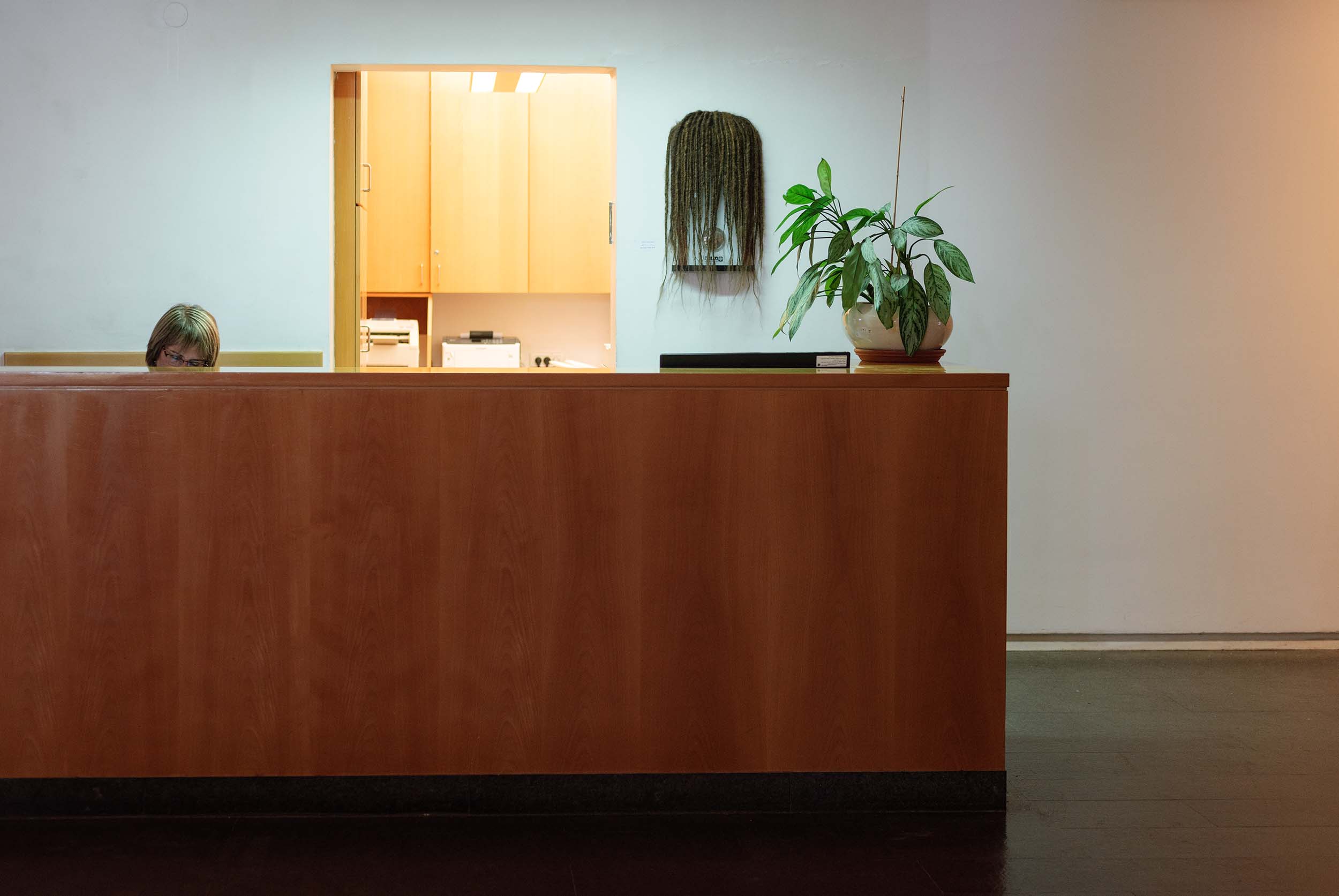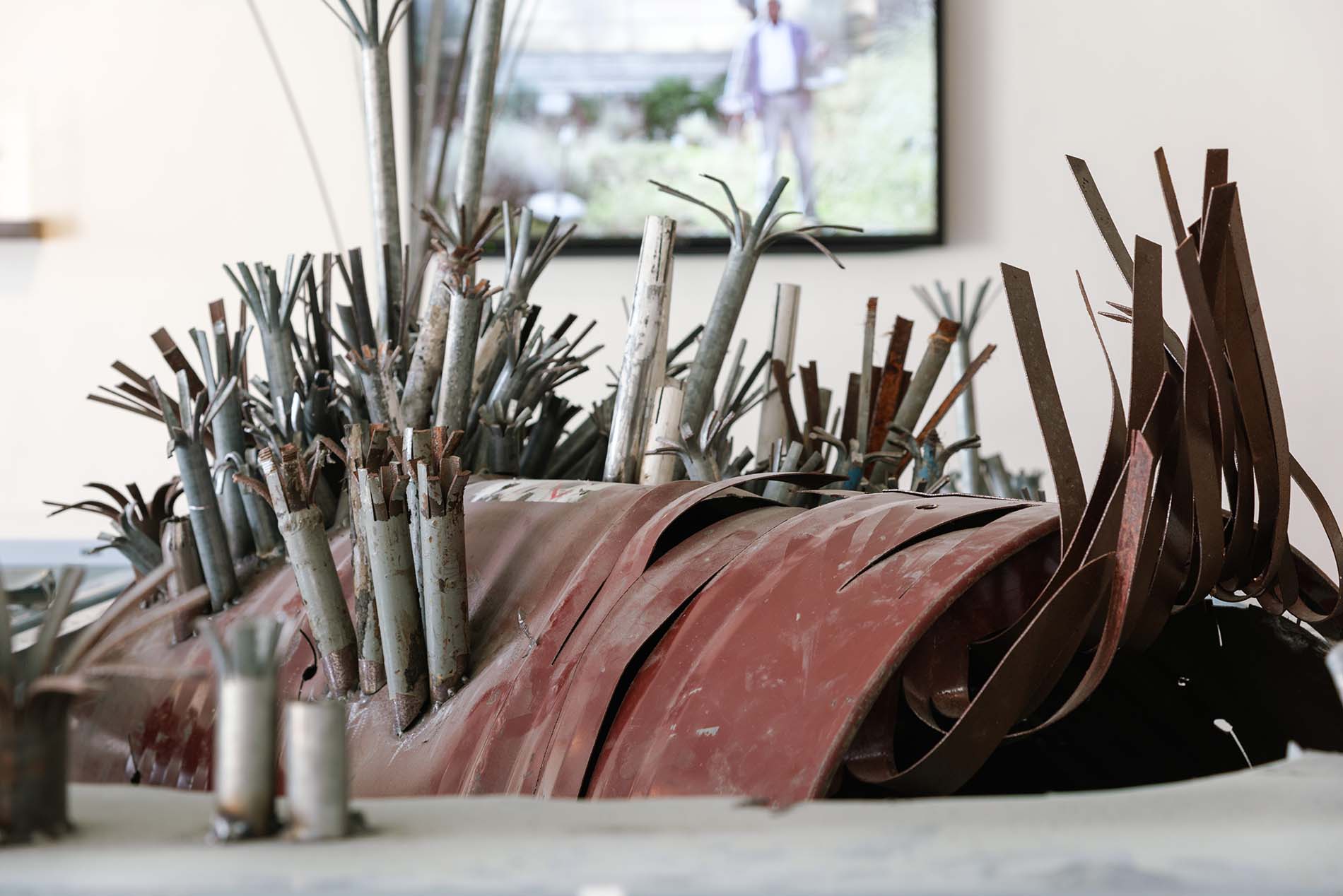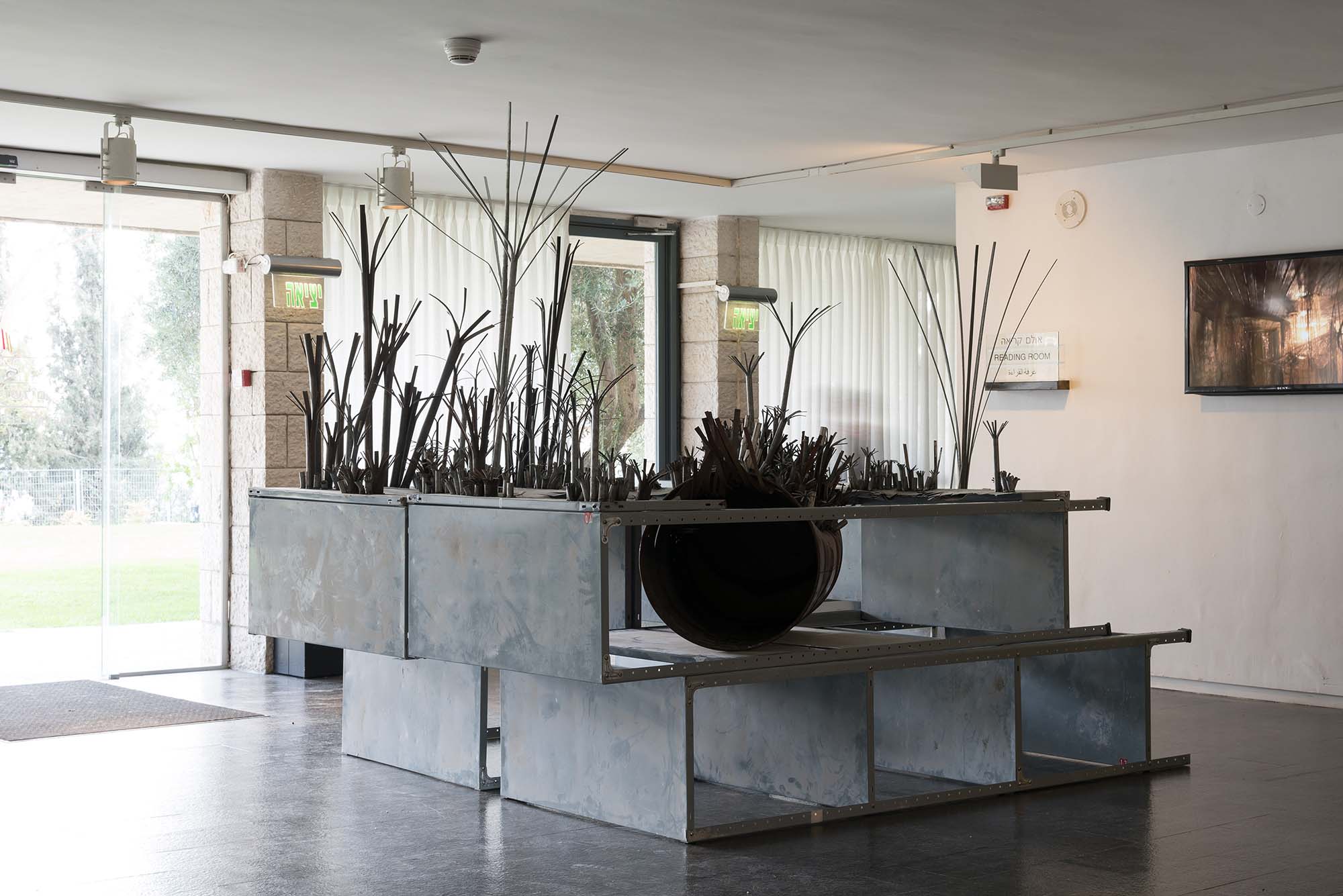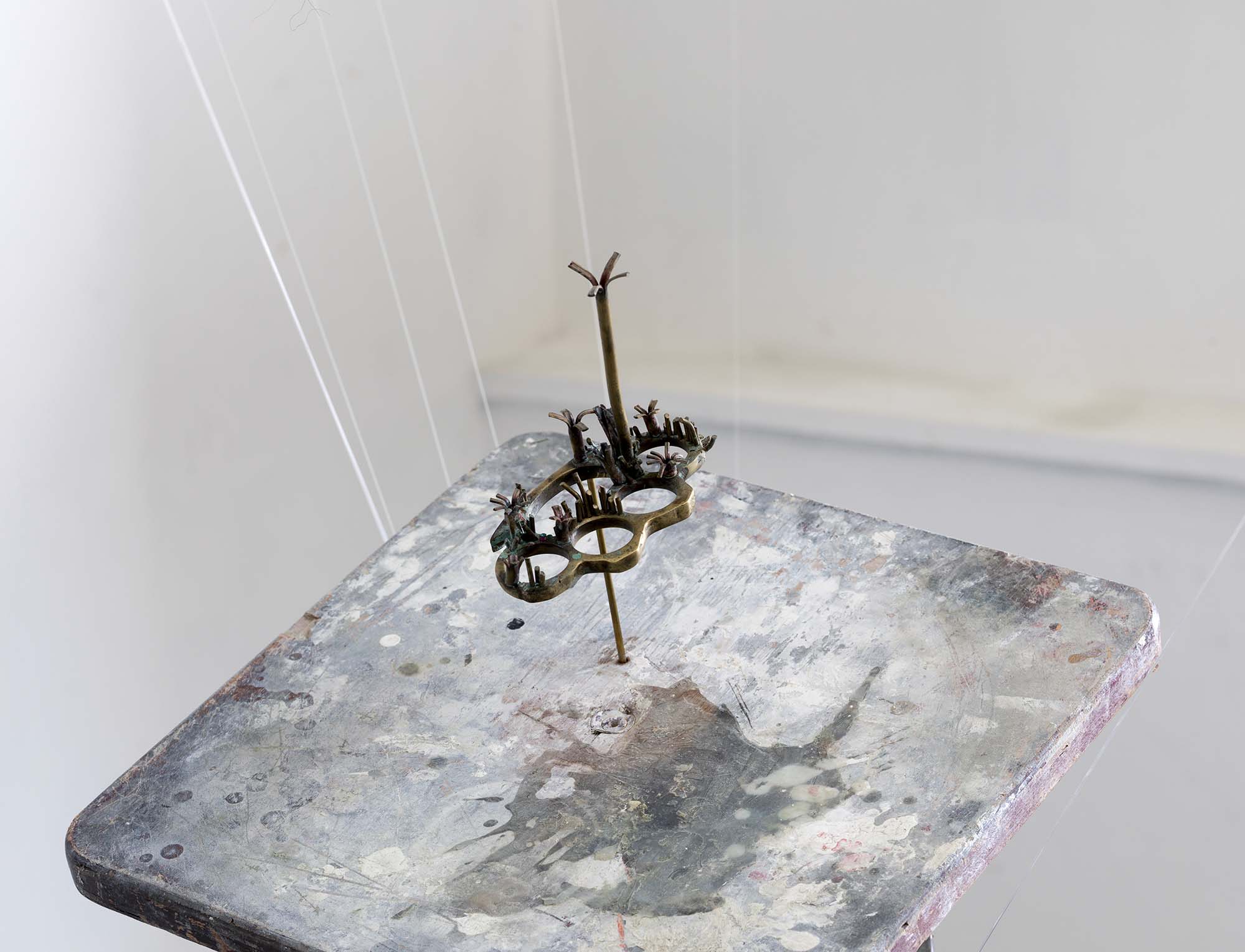Khoushmantoush
at Van Leer institute and Bezalel Academy of Art and Design, Jerusalem. 2018

Menorah, 2018, wall clock, synthetic hair. 25*50 cm. Photo: Kira Kletsky

Menorah, 2018, wall clock, synthetic hair. 25*50 cm. Photo: Kira Kletsky

Khoushmantoush, 2018,metal shelves, metal pipes, barrel, concrete, porcelain cups. 200*300 cm. A detail. Photo: Kira Kletsky

2018, Installation view at The Van Leer Institute, Jerusalem. Photo: Kira Kletsky

Installation view at Bezalel, Jerusalem. Photo: Elad Sarig

Untitled (knuckle-duster), 2018, brass. 5*10*10 cm. Photo: Elad Sarig

Khoushmantoush, 2018,metal shelves, metal pipes, barrel, concrete, porcelain cups, synthetic hair, ‘Brita’ filter. A detail. Photo: Elad Sarig

Installation view at Bezalel, Jerusalem. Photo: Elad Sarig

Installation view at Bezalel, Jerusalem. Photo: Elad Sarig

Installation view at Bezalel, Jerusalem. Photo: Elad Sarig
Khoushmantoush
Following the 1948 War, my family received keys to an abandoned house in Jaffa from the Jewish Agency. It was an impressive, grand house with a large surrounding yard, as well as an inner courtyard that led to all the rooms. On one of their first days in the house, when my grandfather was digging a hole to plant a tree, he discovered a large barrel hidden just under the earth. Of all the contents of the barrel, only two porcelain teacups remain. They were left in my grandmother’s possession and I inherited them last year, following her passing.The slang term ‘Khoshmantush’ derives from the phrase “Rekhuse Natush”, which translates from Hebrew to ‘abandoned property’. Mantush is the Arabic word for ‘detached’. Together, these words phonetically resemble “kusch mein tusch”, which is Yiddish for “kiss my ass”. Avot Yeshurun, an Israeli Poet, used the phase to express the Israeli establishment’s attitude towards Palestinian property abandoned after the war of 1948.
I was exposed to the poetry of Yeshurun through my encounter with my family story, which was the starting point of this exhibition: Following the 1948 Arab-Israeli War, my family, recent immigrants from Morocco, received from the state keys to an abandoned house in Jaffa in which they lived in their first years in Israel. During one of their first days in the house, my grandfather wished to plant a tree in the garden. As he was digging, he discovered a large barrel hidden in the ground, which seemed to have been buried recently. The barrel contained a vast array of valuables: housewares, bedsheets, tablecloths, and other precious ornaments. The new owners found an appropriate use for each of the items found in the loot. The sheets, beautifully decorated with embroidered peacocks, were turned into the walls of my family's Sukkah. A Japanese set of porcelain tableware was used for special occasions. Of all the contents of the barrel, only two teacups from the Japanese porcelain set survived. They were left in my grandmother’s possession, and I inherited them this year, following her passing.
This work was first presented in my graduate exhibition in Bezalel. The installation was created out of the storage systems and the remnants of material within the workshop which also served as the exhibition space. The installation intended to evoke the moment of the discovery of the barrel and transfer it into the workshop of Bezalel. The video work accompanying it scans the ‘Root Research Laboratory” in Tel-Aviv University, documenting the man in charge of maintaining it since it stopped functioning as a site for experiments.
Following the 1948 War, my family received keys to an abandoned house in Jaffa from the Jewish Agency. It was an impressive, grand house with a large surrounding yard, as well as an inner courtyard that led to all the rooms. On one of their first days in the house, when my grandfather was digging a hole to plant a tree, he discovered a large barrel hidden just under the earth. Of all the contents of the barrel, only two porcelain teacups remain. They were left in my grandmother’s possession and I inherited them last year, following her passing.The slang term ‘Khoshmantush’ derives from the phrase “Rekhuse Natush”, which translates from Hebrew to ‘abandoned property’. Mantush is the Arabic word for ‘detached’. Together, these words phonetically resemble “kusch mein tusch”, which is Yiddish for “kiss my ass”. Avot Yeshurun, an Israeli Poet, used the phase to express the Israeli establishment’s attitude towards Palestinian property abandoned after the war of 1948.
I was exposed to the poetry of Yeshurun through my encounter with my family story, which was the starting point of this exhibition: Following the 1948 Arab-Israeli War, my family, recent immigrants from Morocco, received from the state keys to an abandoned house in Jaffa in which they lived in their first years in Israel. During one of their first days in the house, my grandfather wished to plant a tree in the garden. As he was digging, he discovered a large barrel hidden in the ground, which seemed to have been buried recently. The barrel contained a vast array of valuables: housewares, bedsheets, tablecloths, and other precious ornaments. The new owners found an appropriate use for each of the items found in the loot. The sheets, beautifully decorated with embroidered peacocks, were turned into the walls of my family's Sukkah. A Japanese set of porcelain tableware was used for special occasions. Of all the contents of the barrel, only two teacups from the Japanese porcelain set survived. They were left in my grandmother’s possession, and I inherited them this year, following her passing.
This work was first presented in my graduate exhibition in Bezalel. The installation was created out of the storage systems and the remnants of material within the workshop which also served as the exhibition space. The installation intended to evoke the moment of the discovery of the barrel and transfer it into the workshop of Bezalel. The video work accompanying it scans the ‘Root Research Laboratory” in Tel-Aviv University, documenting the man in charge of maintaining it since it stopped functioning as a site for experiments.
כוש מנטוש
״הוא ירושה לא מאבינו-
זה הניב: ׳רכוש נטוש׳.
אזרחים אך זאת הבינו:
כוש מנטוש״
כושמנטוש הינה מילת סלנג משנות ה-50 שמקורה במונח ׳רכוש נטוש׳. ׳מנתוש׳ פירושה ׳תלוש׳ בערבית וצירוף המילים נשמע כמו ׳קוש מיין טוש׳- שק לי בתחת ביידיש. אבות ישורון התשמש בביטוי זה בשירתו כדי לבטא את עמדתו ביחס להתנהלותו של הממסד הישראלי כלפי הרכוש הפלסטיני הנטוש לאחר המלחמה ב-1948. עם בריחתם של התושבים הפלסטינים המקומיים מהערים המעורבות, כדוגמת יפו וחיפה, שיכנה המדינה את העולים היהודיים בבתיהם ומסרה את רכושם.
אל שירתו של ישורון הגעתי מתוך המפגש עם הסיפור המשפחתי שהיווה את נקודת המוצא לתערוכה: מיד לאחר שהסתיימו הקרבות ב-48׳ קיבלה משפחתי מפתחות מ׳הסוכנות׳ לבית נטוש ביפו, בו התגוררה בשנותיה הראשונות בארץ לאחר עלייתה ממרוקו. באחד מימיהם הראשונים בבית ביקש סבי לנטוע עץ בגינה שנזנחה בימות הלחימה. כאשר חפר בור גילה חבית גדולה, חבויה מעט מתחת לפני האדמה מלאה פרטי ערך יקרים: כלי בית, מצעים, מפות וחפצי נוי. לכל אחד מפרטי השלל נמצא על ידי הבעלים החדשים שימוש מתאים, כך הפכו סדינים מעוטרים בטווסים רקומים לדפנות הסוכה של משפחתי, ומערכת כלים יפניים מפורצלן, לכלי אירוח לאירועים מיוחדים. מתוך כל תכולת החבית, שני ספלי תה מהסרוויס היפני הם מה שנותר ברשותה של סבתי, ואלו הועברו לרשותי, בשנה האחרונה, לאחר שנפטרה.
העבודה הוצגה לראשונה בתערוכת הגמר שלי בבצלאל, ונוצרה מתוך מערכות המידוף ושאריות החומרים שהיו מצויים בחדר הסדנא אשר שימש כחלל התצוגה. לצד המיצב הפיסולי, המבקש להתיק את רגע גילוי החבית אל סדנאת הפיסול בבצלאל, עבודת הוידאו סורקת את ׳המעבדה לחקר השורשים׳ באוניברסיטת תל אביב ומתעדת את מי שאחראי על תחזוקתה מאז הפסיקה לשמש כאתר לניסויים.
״הוא ירושה לא מאבינו-
זה הניב: ׳רכוש נטוש׳.
אזרחים אך זאת הבינו:
כוש מנטוש״
כושמנטוש הינה מילת סלנג משנות ה-50 שמקורה במונח ׳רכוש נטוש׳. ׳מנתוש׳ פירושה ׳תלוש׳ בערבית וצירוף המילים נשמע כמו ׳קוש מיין טוש׳- שק לי בתחת ביידיש. אבות ישורון התשמש בביטוי זה בשירתו כדי לבטא את עמדתו ביחס להתנהלותו של הממסד הישראלי כלפי הרכוש הפלסטיני הנטוש לאחר המלחמה ב-1948. עם בריחתם של התושבים הפלסטינים המקומיים מהערים המעורבות, כדוגמת יפו וחיפה, שיכנה המדינה את העולים היהודיים בבתיהם ומסרה את רכושם.
אל שירתו של ישורון הגעתי מתוך המפגש עם הסיפור המשפחתי שהיווה את נקודת המוצא לתערוכה: מיד לאחר שהסתיימו הקרבות ב-48׳ קיבלה משפחתי מפתחות מ׳הסוכנות׳ לבית נטוש ביפו, בו התגוררה בשנותיה הראשונות בארץ לאחר עלייתה ממרוקו. באחד מימיהם הראשונים בבית ביקש סבי לנטוע עץ בגינה שנזנחה בימות הלחימה. כאשר חפר בור גילה חבית גדולה, חבויה מעט מתחת לפני האדמה מלאה פרטי ערך יקרים: כלי בית, מצעים, מפות וחפצי נוי. לכל אחד מפרטי השלל נמצא על ידי הבעלים החדשים שימוש מתאים, כך הפכו סדינים מעוטרים בטווסים רקומים לדפנות הסוכה של משפחתי, ומערכת כלים יפניים מפורצלן, לכלי אירוח לאירועים מיוחדים. מתוך כל תכולת החבית, שני ספלי תה מהסרוויס היפני הם מה שנותר ברשותה של סבתי, ואלו הועברו לרשותי, בשנה האחרונה, לאחר שנפטרה.
העבודה הוצגה לראשונה בתערוכת הגמר שלי בבצלאל, ונוצרה מתוך מערכות המידוף ושאריות החומרים שהיו מצויים בחדר הסדנא אשר שימש כחלל התצוגה. לצד המיצב הפיסולי, המבקש להתיק את רגע גילוי החבית אל סדנאת הפיסול בבצלאל, עבודת הוידאו סורקת את ׳המעבדה לחקר השורשים׳ באוניברסיטת תל אביב ומתעדת את מי שאחראי על תחזוקתה מאז הפסיקה לשמש כאתר לניסויים.
Back to main page